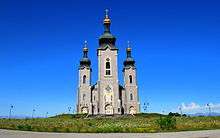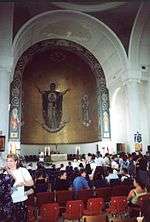Cathedral of the Transfiguration (Markham)
Coordinates: 43°53′39.53″N 79°22′16.17″W / 43.8943139°N 79.3711583°W
| Former Cathedral of the Transfiguration Cathedraltown Markham, Ontario | |
|---|---|
 The former Cathedral of the Transfiguration | |
| Denomination | Slovak Greek Catholic Church |
| Administration | |
| Parish | Ontario |
| Diocese |
Eparchy of Saints Cyril and Methodius of Toronto(1984-2006) Jesus the King Melkite Greek Catholic Church(2016-) |
The Cathedral of the Transfiguration was a Byzantine Revival cathedral of the Slovak Catholic Eparchy of Saints Cyril and Methodius of Toronto. It was originally built in the rural Victoria Square area in Markham, Ontario, north of the city of Toronto. Upon urbanization and development, the former cathedral is now unofficially designated as part of Cathedraltown and serves as the landmark of the Cathedraltown community.
It was built to serve Slovak Catholics throughout the Greater Toronto Area (GTA). The structure closed as a place of Catholic worship in 2006. However, Jesus the King Greek Melkite Catholic Church started to use the cathedral as a place of worship in late November 2016. After completion of mosaic work, the cathedral will fully reopen in early 2017.[1]
Features
Among its features is the world's largest three-bell carillon, with the French-made bells by the Fonderie Paccard, weighing 14 500 kg (32,000 pounds), and 300 cm diameter. The mosaics are reputed to contain about 5 million pieces. The building was built to hold 1000 worshippers serving a community of about 5000 Byzantine Rite Catholics in the GTA and 35,000 across Canada. The central tower rises 63 metres (about 20 storeys) and is topped by a gold onion dome. The church was designed by Donald Buttress, a renowned architect whose claim to fame is overhauling Westminster Abbey.[2] It is a significant landmark east of the 404 highway.
History
The building was conceived and funded by Stephen Boleslav Roman, a Slovak immigrant to Canada who had built up the Denison Mines corporation. Roman both funded and designed the building, modelling the structure on the church in Veľký Ruskov, the Slovak village he was raised in. The cathedral pays tribute to Slovaks oppressed during the Soviet era.[1] The cathedral was built on a donated portion of his Romandale estate.
Work began on the Cathedral in 1984. That year it became the first church in North America to be consecrated by a Pope, when John Paul II blessed the cornerstone during his trip to Canada. Construction took several years, and ran significantly over the original budget of $13 million, eventually costing $30 million.[1]
Roman died of a heart attack in 1988, and did not see the cathedral completed. His funeral service was held in the partially completed structure, with 1600 people in attendance.
On September 24, 1998, Bishop Cornelius Pasichny, OSBM, was enthroned as the new Eparch for Ukrainian Catholics in Eastern Canada (Eparchy of Toronto), with the ceremony taking place at the church.[3]
In 2006, the building was still incomplete, with estimates that completion would take another 10 years.[4]
The exterior of the Cathedral was used in the 1995 movie In the Mouth of Madness, where it portrayed the Black Church located in Hobb's End. It can also be seen on some of the posters promoting the film.
It was also featured in the 2013 Canadian independent film "Rearview" written and directed by Robert Gulassarian.
While originally built in a rural area some distance from the city, the rapidly growing Toronto suburbs now come near to the structure. In 2004 work began on Cathedraltown, a housing development of more than 1200 structures that will surround the Cathedral.
Closure
In 2006, Eparch John Pazak, head of Byzantine rite Slovak Catholics in Canada, removed the blessed sacrament and the altar stone from the structure. The bishop has also suspended permission for his priests to celebrate Mass in the former cathedral and asked the Roman Catholic Archdiocese of Toronto not to permit Roman rite priests to celebrate Mass there.
The Cathedral was closed by the bishop upon being "unable to arrive at a stable, sustainable working relationship with the Slovak Greek Catholic Church Foundation, which owns the property".[5][6][7]
Reports indicate that the last service was June 25, 2006 with the building last open to public in 2009, to celebrate the completion of a 25-metre mosaic addition to the building.[6][7]
Reopening
As of December 2016, the Slovak Greek Catholic Church Foundation was completing mosaic work in the church interior.[1]
Because their church burned down in Richmond Hill, Jesus the King Melkite Greek Catholic Church has been using the cathedral for Sunday mass since late November 2016. In early 2017, the Melkite congregation expects to permanently base itself in the cathedral, after which the cathedral would be available for public events such as concerts.[1]

See also
- Slovak Catholic Eparchy of Saints Cyril and Methodius of Toronto
- Slovak Greek Catholic Church
- John Carpenter's In the Mouth of Madness
- Cathedral Mass Schedule
References
- 1 2 3 4 5 Noor Javed (17 December 2016). "Cathedraltown rejoices as church opens its doors after nearly a decade". Toronto Star. Retrieved 2016-12-17.
- ↑ john bentley mays. "Suburbia with a twist". The Globe and Mail. Retrieved 2011-12-16.
- ↑ "New Bishop for the Eparchy of Toronto". Byzantine Catholic Church in America. 1998-11-11. Retrieved 2010-09-03.
- ↑ https://web.archive.org/web/20100311180746/http://www.catholicregister.org/content/view/49/849. Archived from the original on March 11, 2010. Retrieved December 6, 2009. Missing or empty
|title=(help) - ↑ "The Catholic Register: Giant Slovak cathedral, blessed by pope, stripped of status in dispute". 10 May 2006. Retrieved 30 October 2012.
- 1 2 "Catholic Cathedral of the Transfiguration, a photo from Ontario, Central". TrekEarth. Retrieved 2011-12-16.
- 1 2 Fleischer, David (2010-08-27). "Cathedraltown in progress". Yorkregion.com. Retrieved 2010-09-03.
Newspaper Reports
- "Thousands attend as new cathedral's giant bells blessed." The Ottawa Citizen. Ottawa: Aug 16, 1986. pg. A.23
- "Church at the centre; A European-style community will take shape around golden-domed Byzantine Slovak cathedral Built by magnate with grand vision" by Pat Brennan. Toronto Star. Toronto: Apr 17, 2004. pg. M.01
- "Eparchy site in Markham Roman reticent about role in constructing cathedral" Kelley Teahen. The Globe and Mail. Toronto: Oct 26, 1985. pg. A.21
- "Progress slow on Byzantine shrine Hundreds worship in unfinished cathedral" Caroline Byrne. Toronto Star. Toronto: Jul 3, 1989. pg. A.6
- "1,600 mourn Roman at cathedral he built" Joseph Hall. Toronto Star. Toronto: Mar 27, 1988. pg. A.4
External links
| Wikimedia Commons has media related to Cathedral of the Transfiguration, Markham. |
- Slovak Cathedral of Transfiguration
- List of Cathedrals in Canada
- Photo
- Great Bells
- Urban Toronto, Globe and Mail story
- Toronto Seeker short 2009 article with photo
- National Post story